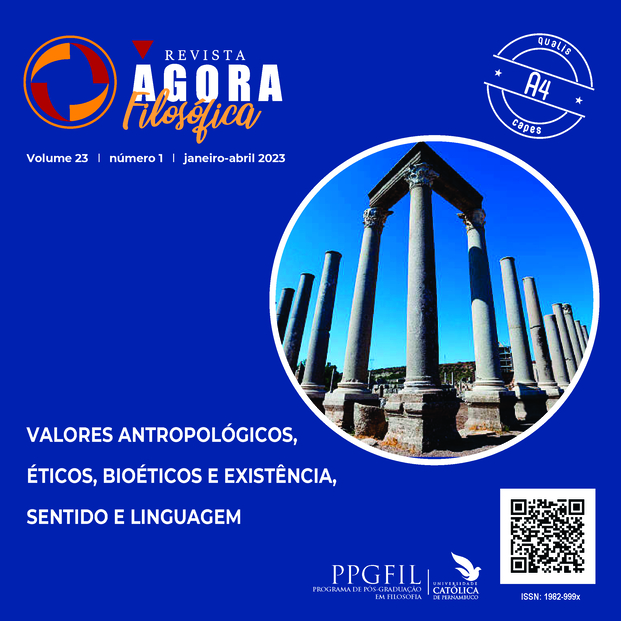If Walls Could Talk: Politics, Sound, Otherness
DOI:
https://doi.org/10.25247/P1982-999X.2023.v23n1.p09-26Palabras clave:
Barriers, Musicology, Political-critical philosophy, Discrimination, Identity, ContemporaryResumen
Este artículo relaciona el tema filosófico del muro y las barreras con la musicalidad. En varias épocas, la música ha tenido un significado político progresista, mientras que el mundo contemporáneo expresa su carácter regresivo en formas musicales comerciales y marketing sonoro. Las formas cerradas y obsesivas del universo tecnológico parecen universos de libertad expresiva mientras que, por el contrario, el lenguaje de las formas armónicas se ha empobrecido y se caracteriza muchas veces por ritmos repetitivos con fuertes repercusiones identitarias. Por ello, el presente ensayo analiza el tema del muro refiriéndose a la música como una forma expresiva y artística nacida para la comunidad y en sí misma abierta. Sin embargo, a menudo hoy en día, la música se utiliza para estrategias de marketing o como vehículo para el suprematismo racial, la discriminación y la xenofobia. Partiendo del análisis de modismos comunes como “si las paredes hablaran” o “las paredes también tuvieran oídos”, este artículo se centra en la diferencia entre la música utilizada como democracia/espacio abierto y como instrumento para una fuerte y cerrada regresión identitaria.
Descargas
Referencias
AA.VV., Government and Opposition, Volume 38, Issue 1, Cambridge: Cambridge University Press, 2003, pp. 113 - 130.
AA.VV., Music and Conflict edited by John Morgano O’Connell and Salwa El Shawan Castelo Branco, Champaign: University of Illinois, 2010.
ADORNO T.W., Philosophy of New Music, Minnesota: Minnesota University Press, 2006.
BLACKING J., The Musical Sense, trans. Eric and Marika Blondel (Paris: Éditions de Minuit, 1980), See How Musical Is Man?, Seattle: University of Washington Press. 1973. -
BENJAMIN W., The Work of Art in the Age of Mechanical Reproduction, London: Penguin, 2008.
COLLI G., Filosofia dell’espressione, Milano: Adelphi, 1969.
DELEUZE G.; GUATTARI F., A Thousand Planes, Minnesota: University of Minnesota Press, 1987.
DONEGANI J.M., Music and Politics: The Language of Music – between Objective Expression and Subjective Reality in Raisons politiques, Volume 14, Issue 2, 2004.
ECO U., The Open Work, Harvard: Harvard University Press, 1989.
GARRATT J., Music and Politics. A Critical Introduction, Cambridge: Cambridge University Press, 2019.
HENWOOD B., The History of American protest music in https://www.vox.com/culture/2017/4/12/14462948/protest-music-history-america-trump-beyonce-dylan-misty
MASSAKA I., Music in the field of Political Sciences. Research, Questions and Trends in Polish Political Sciences, Vol. XLII, 2013.
NIETZSCHE F., Untimely Mediations, Cambridge: Cambridge University Press, 1997.
STREET J., Music and Politics, Cambridge and Malden: Polity Press, 2012.
THOMSON R., The Intertwined Relationship Between Music And Politics in https://liveforlivemusic.com/features/the-intertwined-relationship-between-music-and-politics/, February 2016.
WALTERS D., The aesthetics of Pierre Boulez, Durham University, http://etheses.dur.ac.uk/3093.
Descargas
Publicado
Número
Sección
Licencia
Derechos de autor 2023 Revista Ágora Filosófica

Esta obra está bajo una licencia internacional Creative Commons Atribución 4.0.
Autores que publicam nesta revista concordam com os seguintes termos:- Autores mantém os direitos autorais e concedem à Revista Ágora Filosófica o direito de primeira publicação, com o trabalho simultaneamente licenciado sob a Licença Creative Commons Attribution que permite o compartilhamento do trabalho com reconhecimento da autoria e publicação inicial nesta Revista.
- Autores têm autorização para assumir contratos adicionais separadamente, para distribuição não-exclusiva da versão do trabalho publicada nesta revista (ex.: publicar em repositório institucional ou como capítulo de livro), desde que reconheça e indique a autoria e a publicação inicial nesta Revista.
- Autores têm permissão e são estimulados a publicar e distribuir seu trabalho online (ex.: em repositórios institucionais ou na sua página pessoal) a qualquer momento depois da conclusão de todo processo editorial, já que isso pode gerar alterações produtivas, bem como aumentar o impacto e a citação do trabalho publicado (Veja O Efeito do Acesso Livre).
















